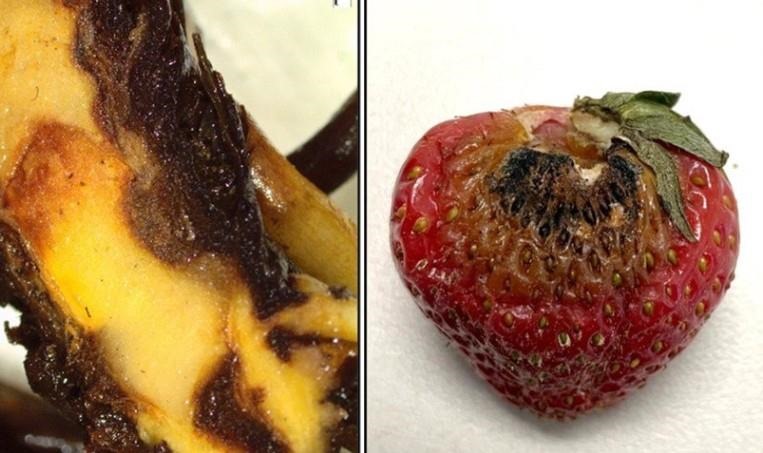By Kathy Demchak
So far, the number of plantings known to have it is very limited in the Mid-Atlantic, but given the speed with which this disease can spread under the right conditions, it is best to remain on the lookout.
The farms with “Neopest” issues had obtained their plants from at least two different plug plant nurseries, though the runner tip source was the same for both. Symptoms would have been apparent last Fall if plants were badly infected, but if a low level of inoculum was present or only a few plants were affected, symptoms may have been easy to miss then.
While the disease progresses more slowly on some cultivars than others, no cultivar is resistant. The main symptom to watch for is tan leaf blotches that rapidly invade leaves under warm moist conditions. These blotches could be mistaken for other leaf spot diseases. The disease symptoms seem not to progress much, if at all when the weather remains cool.

Figure 1. At first, symptoms could be mistaken for any number of common diseases (left), but the invasion of healthy tissue progresses rapidly under warm wet conditions (right). Photos: Karly Regan, Penn State Extension
If you see strawberry leaves with suspicious symptoms, put a few of them in a plastic bag with a wet paper towel in a location with moderate temperatures (70-ish degrees). Lesions that engulf most of the leaf in a few days, followed by black dots (pycnidia) appearing near where the lesion first started forming, and tendrils of spores growing out of the pycnidia afterward are diagnostic. These tendrils of spores are easily knocked off the leaf, so are not likely to be seen in the field. Just one tendril can contain hundreds of spores, but the spores can only be seen under high magnification. The spores are very unique looking (to me) and look more like a silverfish minus its legs than a typical fungal spore.

Figure 2. Numerous black pycnidia and tendrils of spores growing from them that were confirmed to be Neopestalotiopsis. A single spore under high magnification is in the photo to the right. Photos: Kathy Demchak, Penn State
The disease also causes a dark brown crown rot which causes plants to collapse and die and a fruit rot that could be mistaken for other diseases, except for the black sporulation in the center of the fruit lesion.

Figure 3. Dark brown areas of rotting crown tissue caused by Neopestalotiopsis can be seen near the sides and base of the crown (left), and the fruit rot phase of the disease (right). Photos: (left) Kathy Demchak, Penn State; (right) Dr. Mengjun Hu, Univ. of Maryland.
So, what can you do? Infected plants can be pulled out at any point if you wish, but remove them from the field and destroy them - don’t just leave them lying in the field or a cull pile, because they will either just lie there and sporulate, or the crowns will dry out and persist.
When working in the field, be sure to work in areas of the field that have the most disease symptoms last, especially if the foliage is damp. The tendrils of spores fall off in tiny pieces that look like black pepper grains, and they are easily picked up and moved around on your hands or clothing especially when surfaces are wet. There are also some suspicions that this disease has been moved around in water from heavy storms draining from one field to the next in FL, or by workers, though exact circumstances resulting in the migration of the disease are unclear.
Fungicides will be of some help but only provide only partial control. Thiram and Switch are best, but because Switch is used for other diseases, it is best to rely mainly on thiram, as the likelihood of resistance development to Thiram (by any disease) is less. Multiple sprays will be needed at weekly intervals, but be aware that the PHI for thiram is 2 days.
Dry weather during harvest should help in many ways and with many diseases, but of course, this is something you can’t control unless you are using high tunnels or greenhouses. The fact that foliage and fruit remain dry in tunnels is one reason why fruit-rotting diseases tend to “disappear” when they are used.
Once you are finished with the harvest, we recommend not carrying over any infected plantings. Plow under the strawberry crop as soon as possible after harvest. There are indications that Neopestalotiopsis (and anthracnose) persists in fields in mummified crowns, possibly for multiple years. So, plowing under the crowns while they are still green rather than killing off the plants and letting the crowns dry out and then plowing may have benefits, as green tissue is likely to degrade more rapidly. Be sure to clean off your equipment afterward so you don’t accidentally inoculate a new field later.
While we do not have a complete list of other plants that can host this disease, a logical guess would be that annual grains, which host few other diseases in common with small fruit, might be safer rotational crops than some others. Rotate to a new field staying out of strawberries for a minimum of three full years, and longer if at all possible.
Thanks to Dr. Natalia Peres from the University of Florida for the diagnosis of field samples from PA, for her background work on understanding the life cycle and genetics of this disease, and for conducting field trials related to fungicide efficacy. Also thanks to Dr. Mengjun Hu at the University of Maryland for further work on understanding and managing this disease.
Source : psu.edu